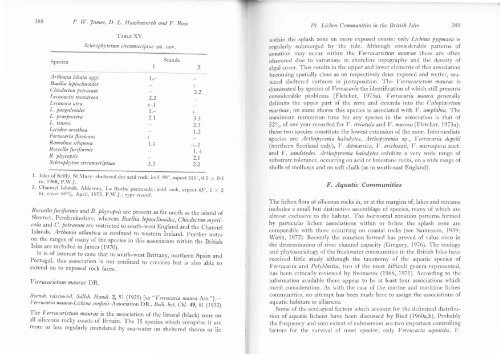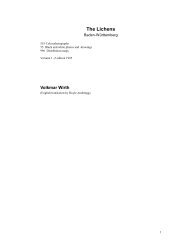Lichen communities in the British Isles: A preliminary conspectus
Lichen communities in the British Isles: A preliminary conspectus
Lichen communities in the British Isles: A preliminary conspectus
Create successful ePaper yourself
Turn your PDF publications into a flip-book with our unique Google optimized e-Paper software.
388 P. W. James, D. L. Hazlhszlorth and F. Rose<br />
Species<br />
Arthonia lohata aggr.<br />
Buellia leptocl<strong>in</strong>oides<br />
Chiodecton petraeum<br />
Lecanactis monslrosa.<br />
Lecanora atra<br />
L. gansaleoides<br />
L. praeposlera<br />
L. tenera<br />
Lecidea oros<strong>the</strong>a<br />
Pertusaria fla.oicans<br />
Ramal<strong>in</strong>a siliquosa<br />
Roccella fuciformis<br />
I?. phycopsis<br />
S c lerophy tor t cir cuntscriptunt<br />
Tanrr XV.<br />
Sclerophytetum circumscriplae ass. nov.<br />
1.-<br />
2.2<br />
+.1<br />
1.-<br />
2.1<br />
+<br />
1.7<br />
J.J<br />
Stands<br />
+ ))<br />
+ J.J<br />
1.2<br />
f,1<br />
1.+<br />
2.7<br />
2.2<br />
1' <strong>Isles</strong> of scilly, st Mary: sheltered dry acid rock. <strong>in</strong>cl. 90o, aspect 315., 0.5 x 0.5<br />
m, 1968, P.W.J.<br />
2. Channel Islands, Al9":l:I, La Roche pen<strong>in</strong>sula: acid rock, aspect 45., 1 X 2<br />
m, cover 600/6, April, 1975, p.W.J. ; type yecord.<br />
Roccella fuc{ormis and, R. phycopsis are present as far north as <strong>the</strong> islancl of<br />
skomer, Pembrokeshire, whereas Buehia reptocr<strong>in</strong>oides, chiodecton myrticola<br />
and c. pett'aeum are restricted to south-west England and <strong>the</strong> channel<br />
Islands. Arthonia atlantica is conf<strong>in</strong>ed to western Ireland. Fur<strong>the</strong>r notes<br />
on <strong>the</strong> ranges of many of <strong>the</strong> species <strong>in</strong> this association with<strong>in</strong> <strong>the</strong> <strong>British</strong><br />
<strong>Isles</strong> are <strong>in</strong>cluded <strong>in</strong> James (1970).<br />
It is of <strong>in</strong>terest to note that <strong>in</strong> south-west Brittany, nor<strong>the</strong>rn spa<strong>in</strong> and<br />
Portugal, this association is not conf<strong>in</strong>ed to crevicls but is also able to<br />
extend on to exposed rock faces.<br />
V err uc arietum maur ae DF..<br />
soensh. z.tcixtsociol. stiltsh. Haydl.. 2, 51 (rgzs) las ,,verrucaria maura-Ass.,,).verrucaria<br />
maura-I'ich<strong>in</strong>a conf<strong>in</strong>is-Associatio''DR., Beih. bot. cbl. 49, gl (1932)<br />
Thc verrucarietum maurae is <strong>the</strong> association of <strong>the</strong> littoral (brack) zone on<br />
all siliceous rocky coasts of Brita<strong>in</strong>. The 15 species which .o-pri." it ur"<br />
more or less regularly <strong>in</strong>undated by sea-water on shertered shtres or lie<br />
10. <strong>Lichen</strong> Communities <strong>in</strong> <strong>the</strong> <strong>British</strong> <strong>Isles</strong> 389<br />
with<strong>in</strong> <strong>the</strong> splash zone on more exposed coasts; only I'ich<strong>in</strong>a pygmaea is<br />
regularly submergcd by thc tide. Althoush considerable patterns of<br />
zonatiorr may occur with<strong>in</strong> <strong>the</strong> Verrucarietum maurae thcse are often<br />
obscurcd due to variations <strong>in</strong> shorel<strong>in</strong>e topographv and <strong>the</strong> density of<br />
algal cover. This results <strong>in</strong> <strong>the</strong> upper and lower elements of this association<br />
becom<strong>in</strong>g spatially close as on respectively drier exposcd and rvctter, seaweed<br />
sheltered surfaces <strong>in</strong> juxtaposition. The Verrucarietu.m maurae is<br />
dom<strong>in</strong>ated by species of Verrucaria thc identification of which still presents<br />
considcrable problems (Fletcher, 1975a). Verrucaria maura generally<br />
delimits <strong>the</strong> upper part of <strong>the</strong> zone and extends <strong>in</strong>to thc Caloplacetum<br />
mar<strong>in</strong>ae; on some shores this species is associated with V. ampltibia.'fhe<br />
maximum immersion time for any species <strong>in</strong> <strong>the</strong> association is that of<br />
52o/o of one year recorded for V. striatula andV. mucosa (Fletcher, 1973a);<br />
<strong>the</strong>se two species constitute <strong>the</strong> lowest ertension of <strong>the</strong> zone. Intermediate<br />
spccies are Arthopyrenia halodTttes, Arthopyrenia sp., Verrucart:.a degelii<br />
(nor<strong>the</strong>rn Scotland only), V. ditmatsica, V. erichsenii, V. microspora atrct.<br />
and V. sandstedei. Arthopyrenia halodytes exhibits a very wide range of<br />
substrate tolerance, occurr<strong>in</strong>g on acid or limestone rocks, on a r,vide range of<br />
shells of molluscs and on soft chalk (as <strong>in</strong> south-east England).<br />
F. Aquatic Cornrnunities<br />
The lichen flora of siliceous rocks <strong>in</strong>, or at <strong>the</strong> marg<strong>in</strong>s of, lakes and strearns<br />
<strong>in</strong>cludes a small but dist<strong>in</strong>ctive assemblage of species, many of w-hich are<br />
almost exclusive to <strong>the</strong> habitat. The horizontal zonation patterns formed<br />
by particular lichen associations lvith<strong>in</strong> or below <strong>the</strong> splash zone are<br />
comparable with those occurr<strong>in</strong>g on coastal rocks (see Santesson, 1939;<br />
Wirth, 1972). Recently <strong>the</strong> zonation formcd has proved of value even <strong>in</strong><br />
<strong>the</strong> determ<strong>in</strong>ation of river channel capacity (Gregory, 1976). l'he ccology<br />
and phytosociology of <strong>the</strong> freshwater <strong>communities</strong> <strong>in</strong> <strong>the</strong> <strong>British</strong> <strong>Isles</strong> have<br />
received little study although <strong>the</strong> taxonomy of <strong>the</strong> aquatic species of<br />
Verrucaria and Polyblastia, two of <strong>the</strong> most difficult genera represcnted,<br />
has been critically reviewed by Sw<strong>in</strong>scow (1968, 1971). Accord<strong>in</strong>g to <strong>the</strong><br />
<strong>in</strong>formation available <strong>the</strong>re appear to be at lcast lour associations which<br />
merit consideration. As with <strong>the</strong> case of <strong>the</strong> mar<strong>in</strong>e and maritime lichen<br />
<strong>communities</strong>, no attempt has been made herc' to assign <strong>the</strong> associations of<br />
aquatic habitats to alliances.<br />
Some of <strong>the</strong> ecological factors which account for <strong>the</strong> delimitecl distribution<br />
of aquatic lichens have been discussed by Ried (1960a,b). Probably<br />
<strong>the</strong> frequency and sum extent of submersion are t\4-o important controll<strong>in</strong>g<br />
factors for thc survival of most species; only Verrucat'ia aquatilis, V.





